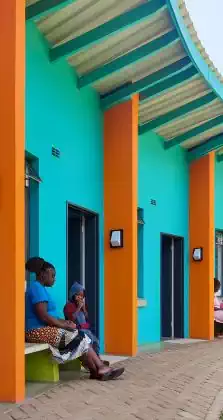Rainbow children's village - health care design








Dire need for health care facilities
Roundtable Zimbabwe and the Meikles Foundation have united their efforts in providing temporary accommodation for Paediatric Cancer patients. Children from disadvantaged families or rural settings rarely attend repetitive chemotherapy treatments in Harare due to challenges in finding lodging and recovery time post-treatment before heading back home. This project attempts to address that need.
Healthcare design concept
Rainbow Children's Village was designed on the Roundtable premises in Belgravia. The overall architectural design takes inspiration from the Rainbow theme in a series of semicircular structures that aim to create sheltered central spaces for the children to play while concentrating services. The structures are brightly coloured bringing joy to the children and reminding them of the rainbow colours. The windows and roofs also jump around to different heights breaking up the building and creating a fun place for the paediatric patients. The overall design idea was to improve the health care through a series of building interventions that would lighten the mood while at the same time providing a protected place to rest and recover.
Phased design
Since the project is entirely funded by donations it was phased to cater for the gradual capital inflow. The single-storey building consists of separate blocks, to facilitate separate construction steps. The first phase would encompass 8 bedrooms for the children and a carer each, toilets and showers, the administration block and the canteen with kitchen and laundry. All essential services will be constructed in the first phase. Subsequent construction phases envisage more bedrooms to be built together with the complimentary toilets.
Floor layouts
The main entrance and administrative block are located just by the parking and entrance gate. A covered entrance leads into the complex passing the reception counter. All visitors are so welcomed and checked before entering the private part of the rest home. The entrance corridor leads to an open-air green area that serves as a protected playground and circulation area to the inner facilities. The administration offices are on the right side of the entrance, while the canteen, kitchen and laundry lie on the left. The bedrooms together with the matron's chambers are further away, facing the green area and distanced from the hustle and noise of the entrance and canteen. All bedrooms are designed for a caregiver and child with all the necessary amenities for a short stay. The rooms are all well ventilated and with abundant natural lighting. Large roof overhangs protect from rain ingress and direct sunlight increasing passive cooling and green design practices.
Bold colours and fun architectural design
With the fun spiral design, bold children's colours and jumbled architectural elements the building design aimed to alleviate the sombre mood experienced by the occupants while at the same time providing a quiet, sheltered resting place to ease the pain. Pantic Architects takes its corporate social responsibility seriously and has taken on this and similar healthcare projects in charitable form, trying to make a positive contribution to our failing medical environment.









